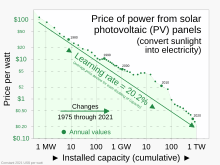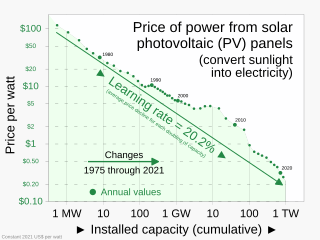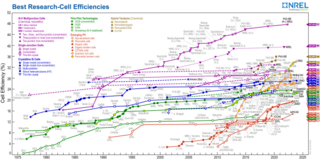
Swanson's law is the observation that the price of solar photovoltaic modules tends to drop 20 percent for every doubling of cumulative shipped volume. At present rates, costs go down 75% about every 10 years. [3]

Swanson's law is the observation that the price of solar photovoltaic modules tends to drop 20 percent for every doubling of cumulative shipped volume. At present rates, costs go down 75% about every 10 years. [3]
It is named after Richard Swanson, the founder of SunPower Corporation, a solar panel manufacturer. [4] The term Swanson's Law appears to have originated with an article in The Economist published in late 2012. [5] [6] Swanson had been presenting such curves at technical conferences for several years. [7]
Swanson's law has been compared to Moore's law, which predicts the growing computing power of processors. Swanson's Law is a solar industry specific application of the more general Wright's Law which states there will be a fixed cost reduction for each doubling of manufacturing volume.
The method used by Swanson is more commonly referred to as learning curve or more precise experience curve analysis. It was first developed and applied to the aeronautics industry in 1936 by Theodore Paul Wright. [8] There are reports of it first being applied to the photovoltaics industry in 1975, and saw wider use starting in the early 1990s. [9]
Crystalline silicon photovoltaic cell prices have fallen from $76.67 per watt in 1977 to $0.36 per watt in 2014. [5] [6] [10] Plotting the module price (in $/Wp) versus time shows a dropping by 10% per year. [11]

In industry, models of the learning or experience curve effect express the relationship between experience producing a good and the efficiency of that production, specifically, efficiency gains that follow investment in the effort. The effect has large implications for costs and market share, which can increase competitive advantage over time.

Photovoltaics (PV) is the conversion of light into electricity using semiconducting materials that exhibit the photovoltaic effect, a phenomenon studied in physics, photochemistry, and electrochemistry. The photovoltaic effect is commercially used for electricity generation and as photosensors.

A solar cell, also known as a photovoltaic cell, is an electronic device that converts the energy of light directly into electricity by means of the photovoltaic effect. It is a form of photoelectric cell, a device whose electrical characteristics vary when it is exposed to light. Individual solar cell devices are often the electrical building blocks of photovoltaic modules, known colloquially as "solar panels". Almost all commercial PV cells consist of crystalline silicon, with a market share of 95%. Cadmium telluride thin-film solar cells account for the remainder. The common single-junction silicon solar cell can produce a maximum open-circuit voltage of approximately 0.5 to 0.6 volts.

A solar panel is a device that converts sunlight into electricity by using photovoltaic (PV) cells. PV cells are made of materials that produce excited electrons when exposed to light. These electrons flow through a circuit and produce direct current (DC) electricity, which can be used to power various devices or be stored in batteries. Solar panels are also known as solar cell panels, solar electric panels, or PV modules.

First Solar, Inc. is a publicly traded American manufacturer of solar panels, and provider of utility-scale PV power plants, supporting services that include finance, construction, maintenance and end-of-life panel recycling. First Solar uses rigid thin-film modules for its solar panels, and produces CdTe panels using cadmium telluride (CdTe) as a semiconductor. The company was founded in 1990 by inventor Harold McMaster as Solar Cells, Inc. and the Florida Corporation in 1993 with JD Polk. In 1999 it was purchased by True North Partners, LLC, who rebranded it as First Solar, Inc.
Sharp Solar, a subsidiary of Sharp Electronics, is a solar energy products company owned by Sharp Corporation and based in Osaka, Japan.

Yingli, formally Yingli Green Energy Holding Company Limited -. Yingli Green Energy Holding Company Limited, known as "Yingli Solar," is a solar panel manufacturer. Yingli Green Energy's manufacturing covers the photovoltaic value chain from ingot casting and wafering through solar cell production and solar panel assembly.
A photovoltaic system, also called a PV system or solar power system, is an electric power system designed to supply usable solar power by means of photovoltaics. It consists of an arrangement of several components, including solar panels to absorb and convert sunlight into electricity, a solar inverter to convert the output from direct to alternating current, as well as mounting, cabling, and other electrical accessories to set up a working system. Many utility-scale PV systems use tracking systems that follow the sun's daily path across the sky to generate more electricity than fixed-mounted systems.

Grid parity occurs when an alternative energy source can generate power at a levelized cost of electricity (LCOE) that is less than or equal to the price of power from the electricity grid. The term is most commonly used when discussing renewable energy sources, notably solar power and wind power. Grid parity depends upon whether you are calculating from the point of view of a utility or of a retail consumer.
TEL Solar, formerly Oerlikon Solar, is a manufacturer of production equipment for the manufacturing of thin-film silicon cells, headquartered in Trübbach, Switzerland, near the border to Liechtenstein. The Japanese electronics and semiconductor company Tokyo Electron acquired the company of about 650 employees from OC Oerlikon in November 2012.

Cadmium telluride (CdTe) photovoltaics is a photovoltaic (PV) technology based on the use of cadmium telluride in a thin semiconductor layer designed to absorb and convert sunlight into electricity. Cadmium telluride PV is the only thin film technology with lower costs than conventional solar cells made of crystalline silicon in multi-kilowatt systems.

Thin-film solar cells are a type of solar cell made by depositing one or more thin layers of photovoltaic material onto a substrate, such as glass, plastic or metal. Thin-film solar cells are typically a few nanometers (nm) to a few microns (μm) thick–much thinner than the wafers used in conventional crystalline silicon (c-Si) based solar cells, which can be up to 200 μm thick. Thin-film solar cells are commercially used in several technologies, including cadmium telluride (CdTe), copper indium gallium diselenide (CIGS), and amorphous thin-film silicon.

Between 1992 and 2023, the worldwide usage of photovoltaics (PV) increased exponentially. During this period, it evolved from a niche market of small-scale applications to a mainstream electricity source. From 2016-2022 it has seen an annual capacity and production growth rate of around 26%- doubling approximately every three years.

Crystalline silicon or (c-Si) is the crystalline forms of silicon, either polycrystalline silicon, or monocrystalline silicon. Crystalline silicon is the dominant semiconducting material used in photovoltaic technology for the production of solar cells. These cells are assembled into solar panels as part of a photovoltaic system to generate solar power from sunlight.

Concentrator photovoltaics (CPV) is a photovoltaic technology that generates electricity from sunlight. Unlike conventional photovoltaic systems, it uses lenses or curved mirrors to focus sunlight onto small, highly efficient, multi-junction (MJ) solar cells. In addition, CPV systems often use solar trackers and sometimes a cooling system to further increase their efficiency.

There are currently many research groups active in the field of photovoltaics in universities and research institutions around the world. This research can be categorized into three areas: making current technology solar cells cheaper and/or more efficient to effectively compete with other energy sources; developing new technologies based on new solar cell architectural designs; and developing new materials to serve as more efficient energy converters from light energy into electric current or light absorbers and charge carriers.
Polycrystalline silicon, or multicrystalline silicon, also called polysilicon, poly-Si, or mc-Si, is a high purity, polycrystalline form of silicon, used as a raw material by the solar photovoltaic and electronics industry.
The Fraunhofer Institute for Solar Energy Systems ISE is an institute of the Fraunhofer-Gesellschaft. Located in Freiburg, Germany, the Institute performs applied scientific and engineering research and development for all areas of solar energy. Fraunhofer ISE has three external branches in Germany which carry out work on solar cell and semiconductor material development: the Laboratory and Service Center (LSC) in Gelsenkirchen, the Technology Center of Semiconductor Materials (THM) in Freiberg, and the Fraunhofer Center for Silicon Photovoltaics (CSP) in Halle. From 2006 to 2016 Eicke Weber was the director of Fraunhofer ISE. With over 1,100 employees, Fraunhofer ISE is the largest institute for applied solar energy research in Europe. The 2012 Operational Budget including investments was 74.3 million euro.
Richard Swanson is an American electrical engineer and businessman, retired founder of SunPower, a solar photovoltaic cell manufacturer.